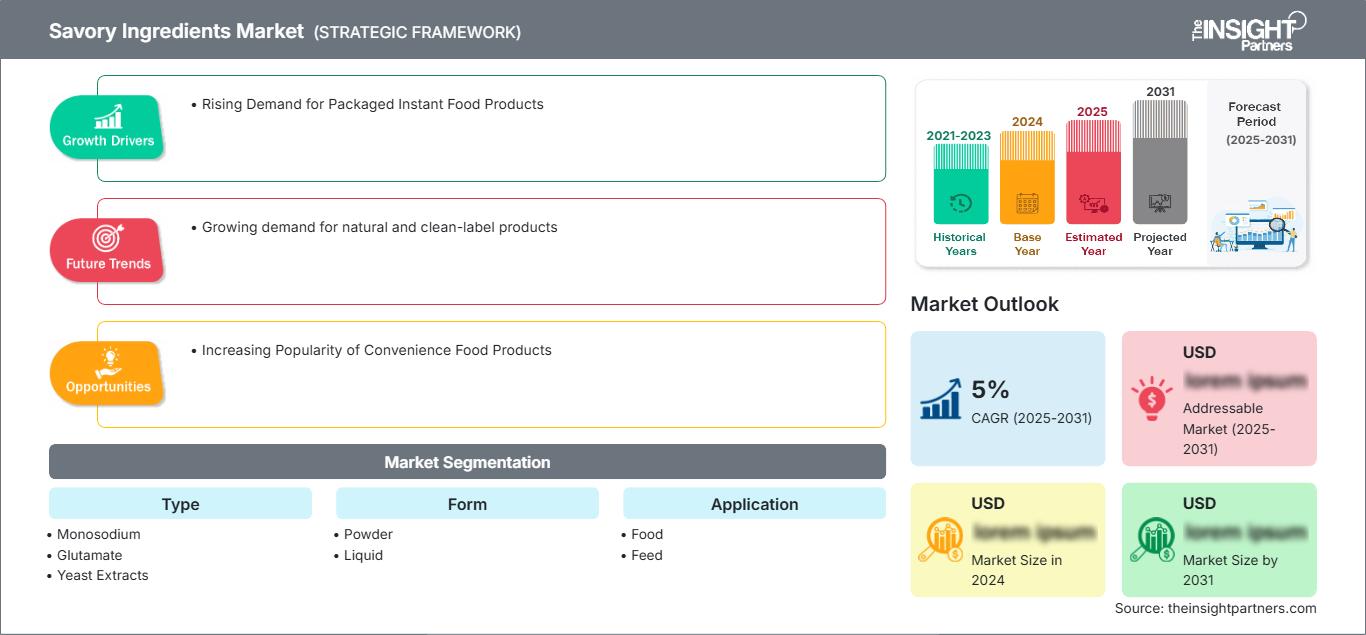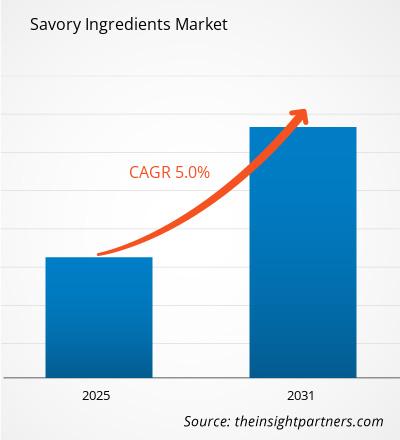页面已更新 :
Sep 2024
预计咸味配料市场在 2023 年至 2031 年期间的复合年增长率将达到 5%。对天然和清洁标签产品的需求不断增长,很可能仍将是市场的主要趋势。
咸味配料市场分析
- 市场主要受对包装即食食品日益增长的需求驱动。这可以归因于不断变化的饮食偏好、人口增长导致的混乱日程安排以及不断膨胀的可支配收入水平,这些进一步导致了世界各地对方便食品的广泛需求。
- 此外,由于人们越来越意识到人工成分的有害影响,消费者对购买清洁标签和天然产品的需求也对市场产生了积极影响。
- 此外,一些主要参与者正在大力投资推出口味更好的改良产品替代品,以满足不同的消费者偏好。
- 由于人们对糕点厨房用品的兴趣日益浓厚,预计未来几年需求将会激增。咸味配料行业的发展也可能对全球咸味配料市场产生积极影响。
咸味配料市场概览
- 咸味配料包括调味品、调味料、增味剂以及薯片和饼干,是构成各种食品风味的重要元素,包括冷冻食品、冷冻零食和方便面。
- 越来越多注重健康的消费者在饮食中选择低脂食品,这推动了咸味配料市场的增长。
- 此外,由于城市化进程的加快,东亚食品在世界范围内的受欢迎程度大幅上升,其中咸味配料是食品制备的重要组成部分。
- 推动市场增长的其他一些因素包括有利的监管支持和人们对烘焙产品日益增长的需求。
自定义此报告以满足您的要求
您将免费获得任何报告的定制,包括本报告的部分内容,或国家级分析、Excel 数据包,以及为初创企业和大学提供超值优惠和折扣
咸味配料市场: 战略洞察

-
获取本报告的主要市场趋势。这个免费样本将包括数据分析,从市场趋势到估计和预测。
- 快节奏的生活方式和对方便、即食食品的渴望导致消费者对包装即食食品的需求增加。
- 这些产品利用咸味配料来提升其风味,创造出消费者渴望的咸味特征。
- 即食餐、小吃和汤等严重依赖这些咸味配料来达到其所需的口味。
- 包装即食食品制备的方便性和简单性使其越来越受欢迎,从而推动了咸味配料市场的增长。
方便食品日益普及
- 方便食品由于其制备简单、速度快,越来越受到消费者的欢迎。
- 这些产品提供快速便捷的膳食解决方案,可满足个人忙碌的生活方式。咸味配料在提升方便食品的风味和口感方面发挥着至关重要的作用,使其对消费者更具吸引力。
- 因此,在这些食品的生产过程中,咸味配料的使用量有所增加。
- 鉴于消费者不断寻求方便、省时的食品选择,预计未来对咸味配料的需求将持续增长。
咸味配料市场报告细分分析
促成咸味配料市场分析的关键细分市场是部署类型和企业规模。
- 根据类型,咸味配料市场分为味精、谷氨酸盐、酵母提取物、HVPS、HAP 和核苷酸。
- 根据形态,市场分为粉末和液体。
- 根据应用,市场分为食品和饲料。
咸味
- 咸味配料市场报告对五大地理区域进行了详细分析,包括当前和历史市场规模以及 2021 年至 2031 年的预测,涵盖北美、欧洲、亚太地区 (APAC)、中东和非洲 (MEA) 以及南美洲和中美洲。
- 每个区域进一步细分为相应的国家/地区。本报告提供对 18 个国家/地区的分析和预测,涵盖咸味配料市场动态,例如影响区域市场的驱动因素、趋势和机遇。
- 此外,该报告还涵盖 PEST 分析,其中涉及研究影响这些地区咸味配料市场的主要因素。
咸味配料市场
咸味配料市场The Insight Partners 的分析师已详尽阐述了预测期内影响咸味配料市场的区域趋势和因素。本节还探讨了北美、欧洲、亚太地区、中东和非洲以及南美和中美洲的咸味配料市场细分和地域分布。
咸味配料市场报告范围
| 报告属性 | 细节 |
|---|---|
| 市场规模 2024 | US$ XX million |
| 市场规模 2031 | US$ XX Million |
| 全球复合年增长率 (2025 - 2031) | 5% |
| 历史数据 | 2021-2023 |
| 预测期 | 2025-2031 |
| 涵盖的领域 |
By 类型
|
| 覆盖地区和国家 |
北美
|
| 市场领导者和主要公司简介 |
|
咸味配料市场参与者密度:了解其对业务动态的影响
咸味配料市场正在快速增长,这得益于终端用户需求的不断增长,而这些需求的驱动因素包括消费者偏好的不断变化、技术进步以及对产品优势的认知度不断提高。随着需求的增长,企业正在扩大产品线,不断创新以满足消费者需求,并抓住新兴趋势,从而进一步推动市场增长。

- 获取 咸味配料市场 主要参与者概述
咸味配料市场评估是通过收集一手资料和二手资料后进行的定性和定量数据进行的,这些数据包括重要的企业出版物、协会数据和数据库。咸味配料市场的一些发展情况如下:
- 味之素株式会社今日宣布与备受尊敬的日本残疾人游泳国家队运动员铃木隆之达成全球合作协议。铃木隆之是一位经验丰富的运动员,曾连续五届残奥会,斩获10枚奖牌,其中包括两枚金牌。根据协议条款,味之素将为铃木隆之提供营养支持,包括提供味之素集团丰富的产品系列。这些产品包括食品(调味料、甜味剂、汤料等)、“aminoVital®”品牌下的氨基酸膳食补充剂(粉剂、片剂、果冻饮料)、冷冻食品和咖啡豆。味之素希望通过这些活动为铃木的表现提供动力,帮助他在运动生涯中不断取得进步。(来源:味之素株式会社,公司网站,2024 年 5 月)。
- 为促进环境保护和可持续发展,嘉吉和非营利组织全球水资源挑战组织 (GWC) 今天宣布在古吉拉特邦坎德拉的 Bhimsar 村开展“整体农村发展”项目。双方合作在 Bhimsar 开展了一项变革性的造林项目,为期三年,覆盖 7.5 英亩土地,旨在保护植物的生物多样性,维持生态系统的维持。该项目将有助于改善土壤质量、地下水位以及 Bhimsar 及周边地区的空气质量。作为实施合作伙伴,古吉拉特邦的非政府组织 Anarde Foundation 将在三年的项目期间种植和维护 3000 棵树苗。 (来源:公司网站,嘉吉公司,2023 年 10 月)
咸味配料市场报告覆盖范围和交付成果
“咸味配料市场规模和预测 (2021-2031)”报告对市场进行了详细的分析,涵盖以下领域:
- 咸味配料市场规模以及涵盖范围内所有主要细分市场的全球、区域和国家/地区预测
- 咸味配料市场趋势以及市场动态,例如驱动因素、限制因素和关键机遇
- 详细的 PEST/Porter 五力模型和 SWOT 分析
- 咸味配料市场分析,涵盖主要市场趋势、全球和区域框架、主要参与者、法规和最新市场发展
- 行业格局和竞争分析,涵盖市场集中度、热图分析、知名参与者和咸味配料市场的最新发展
- 详细的公司简介
- 历史分析(2 年)、基准年、预测(7 年)及复合年增长率
- PEST和SWOT分析
- 市场规模、价值/数量 - 全球、区域、国家
- 行业和竞争格局
- Excel 数据集
近期报告
客户评价
购买理由
- 明智的决策
- 了解市场动态
- 竞争分析
- 客户洞察
- 市场预测
- 风险规避
- 战略规划
- 投资论证
- 识别新兴市场
- 优化营销策略
- 提升运营效率
- 顺应监管趋势
我们的客户































87-673-9708

ISO 9001:2015





 获取免费样品 - 咸味配料市场
获取免费样品 - 咸味配料市场